
Thanksgiving Walkthrough: Gibbslets Gravy
Welcome to the Thanksgiving Walkthrough.
In this article, I'll outline critical fantasy football context for a glorious Thanksgiving of football.
(The stats below are from PFF, NFLfastR, rbsdm.com, RotoViz, FantasyLabs, Fantasy Points, ESPN, and NFL Next Gen).
Subscribers can view the PROE data in a sheet at the bottom of the post.
Rankings and percentiles do not reflect MNF of Week 12.
Quick Links
Bears at Lions, 12:30 PM
Bears Implied Team Total: 19.25
Caleb Williams is coming off a game with middling efficiency, but it came against a very tough Vikings defense. In that context, his performance is actually pretty encouraging.
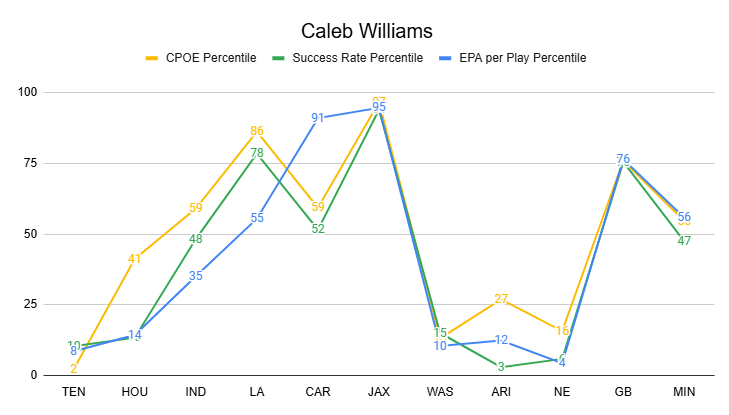
The Bears also put a lot on Williams’ plate. A trailing game script and an agressive 5% pass rate over expected (PROE) yielded a massive 77% pass rate for Williams —a new career high.

New offensive coordinator Thomas Brown wasn’t working to hide his rookie QB last week. And Williams was generally up to the challenge while handling a ridiculous 54 dropbacks — the highest mark of Week 12.
While Thomas didn’t try and hide Williams in a macro sense, he also wasn’t just throwing him in the deep end and demanding he sink or swim. Chicago’s pass-heavy scheme was designed to help Williams get the ball out quickly.
Williams attempted 11 screen passes, also the highest mark of Week 12… and tied with Jayden Daniels (Week 2) for the highest total of the entire NFL season. Williams completed all 11 of these throws for 91 yards and a TD, cashing in on the opportunity for schemed-up production. This screen utilization contributed to a 2.42-second time-to-throw (TTT) that was the third-fastest mark of the week.
But Williams' quick TTT was about more than just screens. From Weeks 1-10, Williams had a 3.21s TTT on non-screen passes – the seventh slowest. Over the last two weeks with Brown as his OC, he’s improved that to 2.98s – 14th slowest.
Williams is still running around and trying to make plays under Brown, but he’s also getting the ball out more in rhythm.
Brown also seems to trust Williams more than Waldron did to be the centerpiece of the offense. Last week, he operated with an 8% PROE on 1st down — the Bears’ highest mark of the season.

All in all, Brown – who I was pretty bearish on after his stint as Bryce Young’s OC last year – looks like a major improvement over Waldron. He looks to have designed a more functional offense while also showing more faith in, and playing to the strengths of, his rookie QB. We love to see it.
Granted, Williams’ hasn’t been amazing over the last two weeks, just better. For the season overall, he still looks unimpressive.

If Williams were heading into a soft matchup this week, I’d be far less concerned about his bigger-picture efficiency. Instead, he gets the league’s top-ranked team in EPA allowed per play.

This is where Thomas Brown’s belief in Williams is so crucial. Despite having a great pass defense, teams are averaging a 68% pass rate against the Lions – a phenomenon driven by Detroit’s ability to put up points in bunches.

Some teams fight this dynamic, as we saw with the Colts last week. But when teams lean into the pass-heavy game script that Detroit typically offers, things can get pretty nutty.

So, this week, we can’t count on strong efficiency from Williams. But he looks like a good bet to be functional. And with functional efficiency, we could see another very sizable dropback tally.
Unfortunately, Chicago’s targets remain split. And Keenan Allen isn’t going away.
Allen is coming off a 16-target game that produced a 9/86/1 receiving line. And if the goal is to get the ball out more quickly, it makes sense that Allen would be involved. Technically, DJ Moore has the lowest aDOT of the Bears’ top three WRs, but that number’s dragged down by his involvement in the screen game. On non-screen targets, Allen has a 10.9 aDOT, with Moore at 11.6. Rome Odunze is the clear deep threat, with a 15.0 aDOT on non-screen targets.
Because volume looks like a safer bet than efficiency here, Allen looks like a decent play.
D.J. Moore has nine screen targets over the last two weeks, which easily leads the league. But Moore’s non-screen targets are a bit concerning – he’s seen just five over the last two weeks. And with screens dominating his target total, he has an aDOT of only 1.8 under Brown. The screens are nice, but we could use more downfield production.
Still, Moore has been very productive in this role, thanks to his explosive YAC ability. In a more limited passing volume setup, he’d be a boom/bust play. But heavy volume here should guarantee at least a few screens, building in a solid floor.

As a downfield threat, Rome Odunze is a bit more boom/bust than his counterparts. But last week’s disappointing 5/39/0 line still came on eight targets. Since the Bears’ Week 7 bye, he’s averaging 7.4 targets per game. He hasn’t been efficient this season, which could again be a struggle here. But he has a defined role in an offense that should have enough volume to support multiple weapons.
Shane Waldron’s usage of Cole Kmet was strange and frustrating. Brown has restored him to a clear starting role, with 87% and 80% marks in route participation over the last two weeks—yet another sign that Brown has a much better handle on things than Waldron did.
Kmet saw 10 targets last week, only four of which were first-read. In other words, he’s on the field again, and earning his targets. He’s a solid TE2.

D’Andre Swift looks like a potential loser in the OC switch. In Brown’s two games, Swift has seen snap shares of 57% and 55% — but Roschon Johnson leads 6-to-1 in red zone carries. Johnson also leads 4-to-1 in the uber-valuable carries inside the 5. There’s also the small issue that Swift has been a very bad runner this year, aside from his penchant for ripping off long runs.
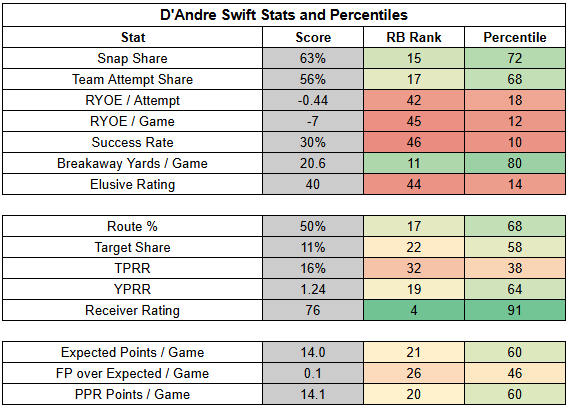
This week Swift gets an impressive Lions defense that could keep a lid on his explosiveness.

Swift is also averaging just three targets over the last two weeks for an 8% target share, so his receiving role isn’t a great bet to save him from a lack of high-value carries. He looks like a high-end RB3 as a bet on big runs, plus some receiving usage in a high-volume game environment.
Lions Implied Team Total: 29.25
The Lions have one of the clearest identities in the league, built on dictating the run to their opponents.
But then, how do I explain the Lions posting positive overall PROEs and aggressive rates on 1st-and-10 over the last two weeks?

The answer is that the Lions are a sharp run-heavy team. They are built around the run, but they also believe firmly in their passing game. Even more importantly, they’re playing to win. If they need to dial up the pass more than the game plan strictly calls for, they’re usually willing to do so. But even then, we have to consider what the typical Lions game script calls for… because it’s not a lot of passing volume.
Even with aggressive play calling relative to expectations these last two weeks, the Lions have had pass rates of just 49% and 56%. Sure, those are above the expected rates in those games, but they’re still quite low.
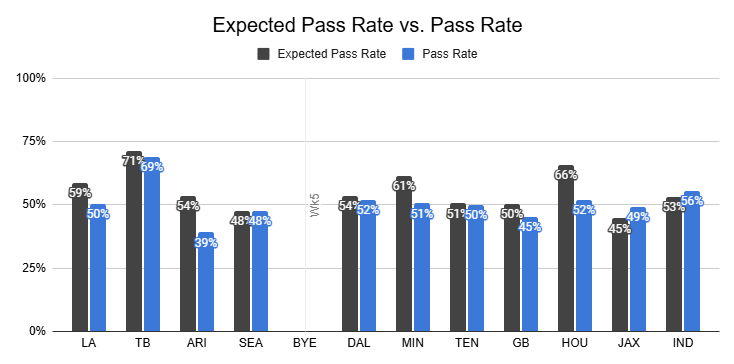
Jared Goff is averaging just 31 dropbacks per game, just below Jalen Hurts (32). And if we’re getting Hurts-level passing volume plus Goff-level rushing production… well… we need some really strong passing efficiency.
For much of the season, Goff has delivered.
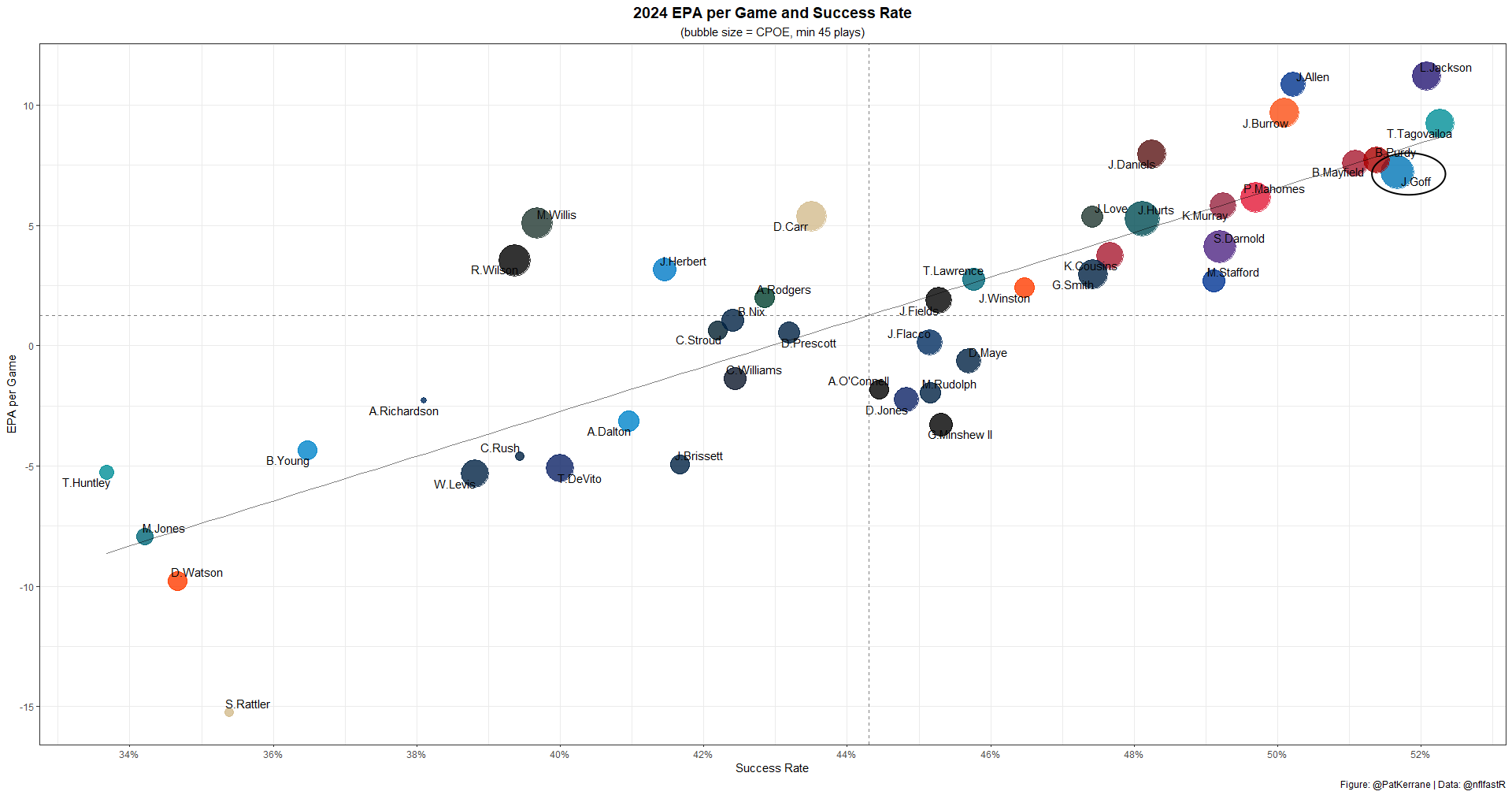
Goff has been especially impressive recently, taking advantage of two soft passing matchups. Against the woeful Jaguars, he put up one of the most efficient passing days in recent memory – throwing for 412 yards and four TDs on just 29 attempts. Against the Colts, he was merely very good.

Goff now gets a Bears defense that is better than the Jaguars or Colts against the pass.
Although, exactly how much better is up for debate. Over the last five weeks, the Bears rank just 23rd in EPA allowed per dropack and 18th in dropback success rate. And over the last two weeks they rank just 26th in both metrics.
Even more concerning for the Bears... is how they’re getting beat through the air. In Week 11, Jordan Love generated 6.2 EPA on play action — the seventh-highest total of the week. Subsequently, Sam Darnold gashed the Bears for 9.6 EPA on play action — the highest mark of Week 12.
Jared Goff leads the league with a 38% play action rate and leads the NFL with 4.2 EPA per game on play action.
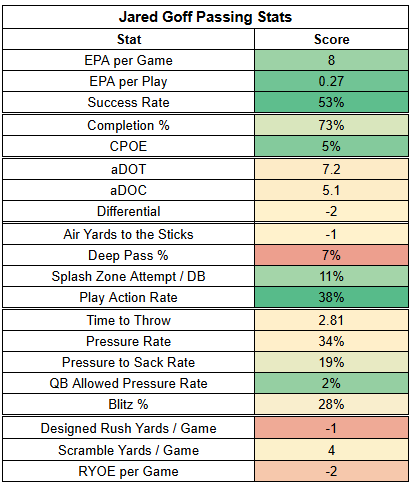
The Bears are also getting beat downfield. In Week 11, Love posted the highest EPA per dropback on intermediate throws. In Week 12, Sam Darnold posted the highest EPA per dropback on deep throws.
This fits with a weakness the Bears have had all season – giving up explosives and failing to protect the deep middle of the field. Just like being deficient against play action, this is a terrible weakness to have against the Lions, who are extremely explosive and love to attack the splash zone (10+ yards downfield and over the middle).

So, in the Bears, we have a matchup that, on the surface, looks much more difficult than what Goff’s faced recently. But ultimately, it might not be overly challenging — especially if the Lions are efficient on the ground against a beatable run defense.
There’s also the potential for Caleb Williams to push the Lions on defense. All in all, this sets up as a sneaky-high upside spot for the Lions’ passing game.
Amon-Ra St. Brown is the heartbeat of that attack, combining a 2.30 YPRR with an elite 29% target share.
St. Brown has missed practice with a knee injury this week. Given that he logged 100% route participation last week, it’s unclear when he sustained it. But Dan Campbell said he’s feeling good about him this week, to the point that he’s considering using him on punt returns. His status is very much worth keeping an eye on but for now St. Brown is a locked-in WR1.

St. Brown is two weeks removed from an 11/161/2 receiving line, so there’s nothing sneaky about his upside here. Jameson Williams, however, is more of a boom/bust play who looks to have legitimate blowup potential, given the Bears’ weakness downfield. He leads the Lions in splash zone target rate, and barely trails St. Brown with a 2.28 YPRR. He looks like the most fun play on the slate.
Sam LaPorta returned from injury and jumped right back into his normal role against the Colts, with 85% route participation. Unfortunately his uninspiring 15% TPRR and 9% first-read target rate were also in line with his typical role.

The Lions, once again, have nearly a 30-point team total here, so LaPorta’s TD equity is pretty strong. And with 1.61 YPRR, it’s not like he’s been bad this year… when targeted.
There’s also another glimmer of upside for LaPorta in this matchup — the aforementioned potential for strong play action production. If that is ultimately what drives much of the Lions’ success this week, LaPorta should be involved. He has a 23% targets per route run on play action, leading Jameson Williams (22%) and Amon-Ra St. Brown (21%). He’s not nearly as fun a play as the WRs, but it’s possible he’s featured a bit more than usual.
It’s hard to see how the Lions don’t feature Jahmyr Gibbs this week. For one thing, the Bears defense has been a bit of a run funnel.

Since Chicago's Week 7 bye, Bears opponents have peaked at just a 64% pass rate, with the Cardinals, Patriots, and Packers all posting 50% or lower.

And the Bears are not impressive against the run—yet another less-than-ideal weakness against Detroit.

Jahmyr Gibbs is a great play under normal circumstances, but this week David Montgomery is dealing with a shoulder injury – potentially tilting the backfield even further in Gibbs’ favor. With Montgomery missing some time last week, Gibbs posted a 67% snap share, his highest of the season.
Gibbs has been less consistent than Montgomery, with a 38% success rate to Montgomery’s 44%, but he makes up for that with elite burst and explosiveness. He’s also a very strong receiver.

Motgomery is expected to play this week, but even a slightly reduced workload for Montgomery could be meaningful here… because it could boost Gibbs’ receiving value.
While Sam LaPorta leads Amon-Ra St. Brown and Jameson Williams in TPRR on play-action… he doesn’t lead the Lions. And neither does Gibbs. Surprisingly, David Montgomery is the top dog here, with a 27% TPRR on play action. This isn’t tiny sample noise, either; with 17 play-action targets this year, Montgomery trails only Javonte Williams (18) and Najee Harris (18).
So if Gibbs sees more of the traditional rushing looks, he should also see more looks on rushing fakes, further boosting his value.
Montgomery’s health will be critical to monitor for Gibbs' outlook, but also because this looks like a great matchup for him if he’s good to go. And even if he doesn’t get his full workload, Montgomery could still end up seeing some high-value touches.
His success rate is elite, and he’s one of the best tackle-breakers in the league. His continued short-yardage usage makes perfect sense. He’s also impressed as a receiver this year, and his 9% target share isn’t far behind Gibbs’ 11%. Montgomery is an RB2.

Back to Quick Links
Giants at Cowboys, 4:30 PM
Giants Implied Team Total: 17
There are numerous reasons why football is the best sport. And while it’s not near the top of the list, this reason is definitely on it: It’s very difficult to tank successfully.
Losing games is easy enough. But losing games without losing the locker room? Without losing your job? If you don’t think that’s a hell of a needle to thread, “Talk to Dabs about that.”
As frustraingly ineffective as Daniel Jones has been this year, starting Tommy DeVito is clearly a tank job.

When kept clean last week, DeVito was reasonably good, with 8.3 EPA and an 8.0 yards per attempt. But he was a disaster under pressure, with -14.8 EPA, a 2.1 YPA, and four sacks.
DeVito's ability to handle pressure is pretty pertinent, since the only thing the Cowboys do well these days on defense is getting after the passer. Dallas ranks sixth in pressure rate, which is saving a bad defense from being an atrocious one.
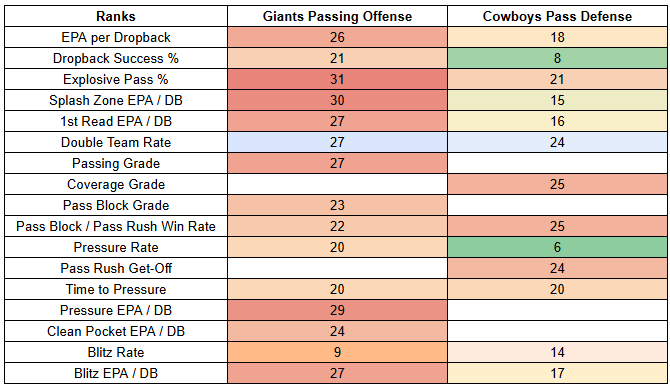
The Giants also rolled out DeVito last year, and are familiar with what he has to offer. They know they need him to get the ball out quickly. Last week, he totaled 2.5 EPA and a 7.5 YPA on quick throws. But on throws of 2.6+ seconds, he was at -10.4 EPA and a 5.3 YPA.
Crucially, and contrary to his understandable frustration with the direction of the offense, Malik Nabers was a key component of this quick-pass game plan. He saw a 28% TPRR on quick throws, accounting for five of his nine targets, and tying Wan’Dale Robinson for the team lead. Nabers also had a strong 21% first-read target rate. While he might not be super efficient this week, he’s unquestionably going to be involved.

Wan'Dale Robinson looks like a decent fit for DeVito’s ‘oh-god-hurry-please-hurry-and-throw-it’ playstyle. He’s not a high upside play, but this setup should make him solidly productive again here.
Darius Slayton was held without a catch last week. More concerningly, he saw just 53% route participation, making him a shaky-at-best dart throw.
Theo Johnson also dropped to just 63% route participation last week, with Daniel Bellinger mixing in for 12 routes, to Johnson’s 25. That usage could just be a blip, and Johnson still managed six targets for the third straight week. Still, it’s not ideal, given all of the other red flags in this offense and Johnson’s profile.
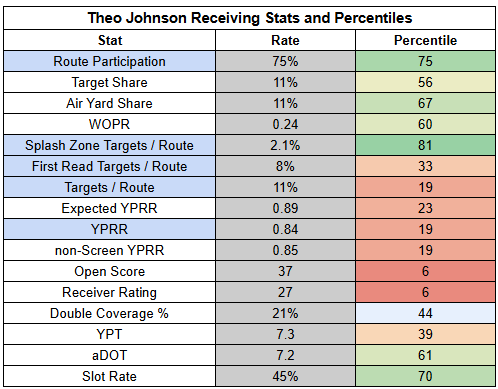
We did have one silver lining with DeVito under center last week, though — the Giants were willing to pass.

In negative game script against the Buccaneers, the Giants didn’t hide DeVito at all – producing a sky-high 74% pass rate. Most offenses in this spot would hide DeVito… but the Giants are committed to the tank.

Even facing Cooper Rush this week, the Giants are clear road underdogs – a good sign for their potential passing volume.
However, last week’s Bucs defense was pretty solid against the run and pretty damn weak against the pass. Meaning that Brian Daboll could have a very different game plan this week, facing the worst run defense in the league.

Theoretically, Tyrone Tracy should be one of the bright spots of this offense – he’s a rookie with promising breakaway ability. But Tracy is literally fumbling away his opportunity. With a goal line fumble last week, he saw just a 41% snap share. Devin Singletary nearly matched him with a 36% share.
Anything short of workhorse usage is a problem for Tracy. He’s flashed some explosiveness, but has otherwise been inefficient.

But even with Tracy struggling, Singletary hasn’t been any better.

Ultimately, we’re likely to see Tracy back in a lead role. But his ball-security issues make it hard to trust he’ll be at the high-end 72% and 80% snap shares he saw in Weeks 9 and 10. Still, given how soft this matchup is, he’s a high-end RB3.
Cowboys Implied Team Total: 20.5
Cooper Rush’s efficiency this season has been strikingly similar to Tommy DeVito’s last week — we shouldn’t expect to see good QB play in this game.
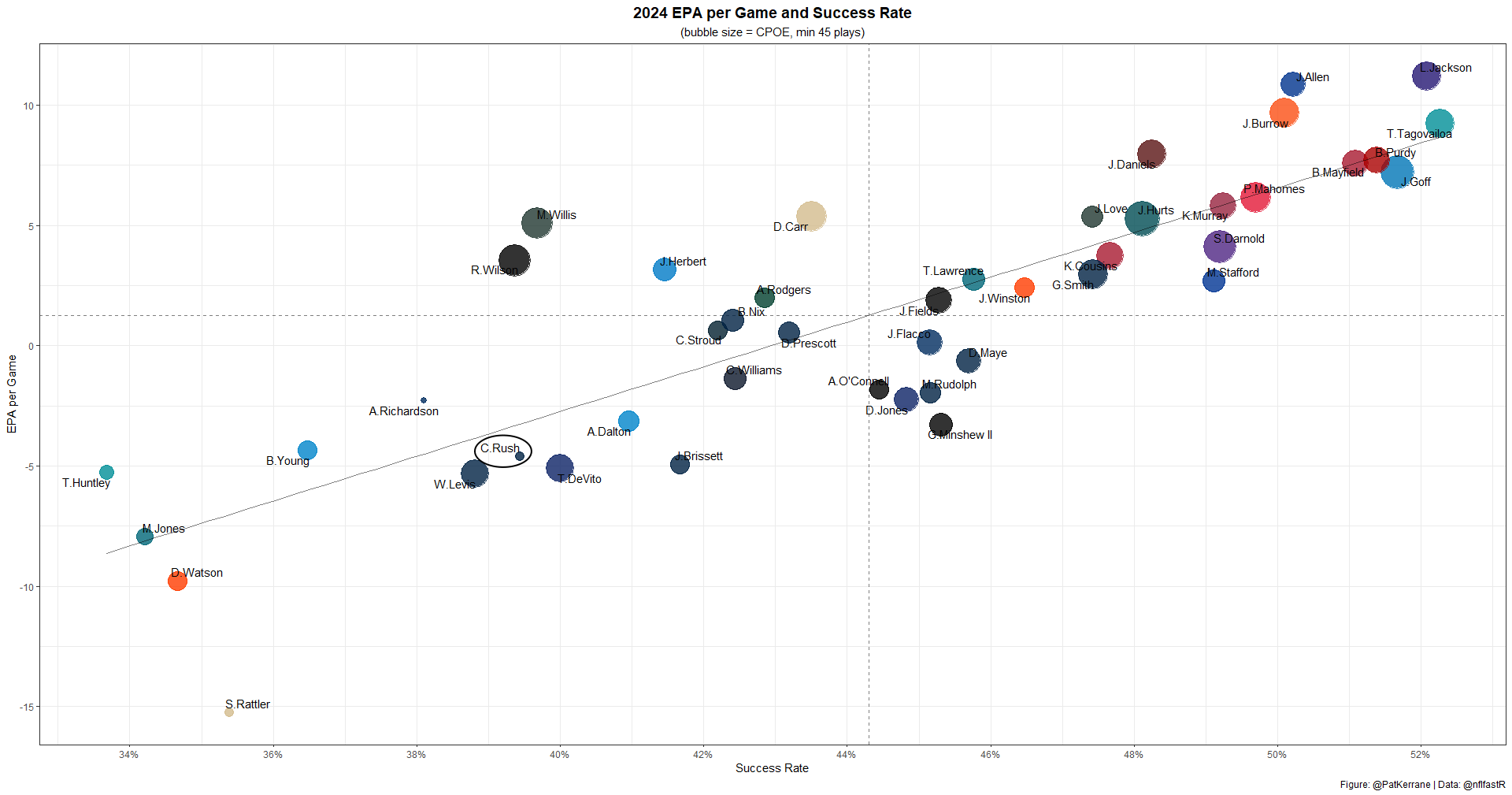
The good news is that Rush is coming off a strong showing against the Commanders, by far his best of the season.
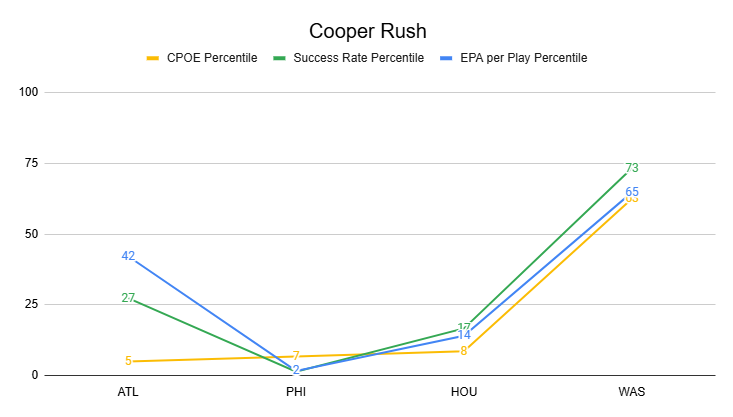
The bad news is that Rush posted 6.9 EPA under pressure – the league’s highest mark in Week 12 – with -0.4 EPA when kept clean, QB21 on the week. That confounding formula is much harder to sustain than the reverse. And much of Rush’s efficiency was driven by this throw to an extremely wide open Luke Schoonmaker. The EPA numbers don’t know that Luke Schoonmaker was left completely wide open in the middle of the field… making this formula even less sustainable than it looks on paper.
The great news is that Rush now gets a Giants defense that is very vulnerable to the pass. The Giants have a solid pass rush, but are very weak in coverage, particularly against first-reads.

This looks like a pretty great fit for Rush, who is getting the ball out extremely quickly. The Giants aren’t letting up a lot of explosives, but that’s not Rush’s game. Instead, he’ll try and win with a conservative and fast-paced passing game. And that’s actually a formula to move the ball against the Giants.
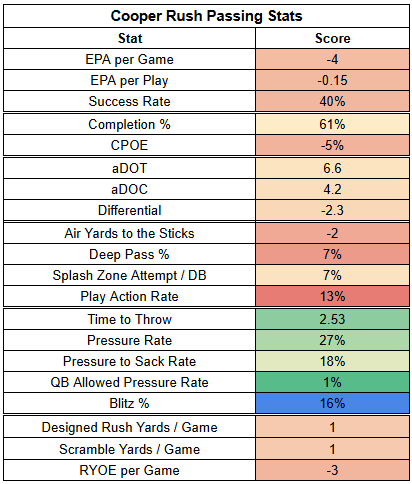
Even with a soft matchup on tap, it’s hard to get excited about anyone in this offense besides CeeDee Lamb. And even Lamb’s profile is getting crushed by the Rush experience. Against the Commanders – again, a strong game for Rush – Lamb turned 10 receptions into just 67 yards. His 6.7 YPT was largely the result of an extremely shallow 3.8 aDOT. Lamb’s 2.03 YPRR was a good mark, but it’s rough when this level of raw production feels like a ceiling outcome.
Still, Lamb is a special talent. With Rush having potential for reasonably efficient play here, he’s in the low-end WR1 mix.
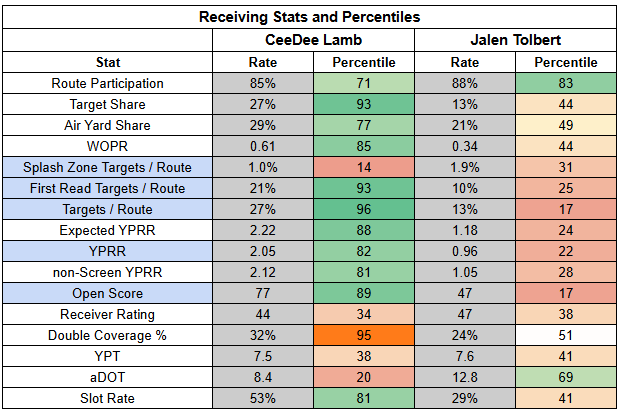
Jalen Tolbert logged 100% route participation against the Commanders and was the only Cowboys WR other than Lamb at 33%+. He hasn’t been good this year, but he’ll be out there—which we can’t say for many Cowboys.
Early indications are that Jake Ferguson will miss this game as he recovers from his concussion, putting Luke Schoonmaker in line for another start. Schoonmaker saw 59% route participation last week, well short of a full-time role; Brevyn Spann-Ford mixed in for 47%. Schoonmaker went 3/55/1 on three targets, but that included the uncovered 24-yard TD. His unimpressive 15% TPRR tells the more accurate story. He’s a dart throw.

The Cowboys have been making noise about running the ball more, so it’s funny to see the exact same PROE profile against Washington that we saw in Week 11 against Houston.

But the Cowboys did run the ball more last week. And maybe this is what the Cowboys meant. They wanted to run the ball more… because they were sick of being in consistently negative game script. ‘We want to run the ball more’ – aka – ‘We’d like to win our first game since Week 5.’

The Cowboys are now home favorites against a Tommy DeVito offense and a weak run defense.

And the league seems to have shifted to attacking the Giants on the ground. They haven’t seen a 54%+ pass rate or a positive PROE against them since Week 6.

Rico Dowdle has not been explosive this season. In fairness, he accounts for half of the Cowboys’ 15+ yard runs this year, and 100% from the backfield. But… he’s had just two 15+ yard runs all season — a 15-yard burst up the middle against the Falcons in Week 9, and a 19-yard up-the-middle carry where he made an Eagles defender miss in the hole. Per NFL Next Gen, he’s hit 15+ MPH just 11 times this year. Saquon Barkley has hit that mark 50 times.
Clearly, we’re not counting on explosiveness here. But we can count on consistency. Dowdle has a solid 41% success rate; he’s generally getting what is blocked or better. He’s also a solid passing game contributor. And with Dak Prescott done for the year, this matchup is one of his last best chances for value. He’s worth firing up as a high-end RB3.

Back to Quick Links
Dolphins at Packers, 8:20 PM
Dolphins Implied Team Total: 21.75
Last week, the Dolphins faced a Patriots defense that was comically unprepared to stop them in the splash zone. Attacking 10+ yards downfield and over the middle has been the hallmark of the Miami offense for the entire Mike McDaniel era. Jerod Mayo has been on the Patriots staff since 2019, playing McDaniel twice a year since 2022. But the Dolphins rolled into town and picked up five 1st downs on splash-zone throws, the second-highest mark by any team all season. The Patriots' inability to stop the Dolphins obvious plan A was both embarrassing and predictable.
In this soft matchup, Mike McDaniel opened up the passing offense, posting a season-high 10% PROE. Miami's 7% PROE on 1st down was also their highest mark in a game with Tagovailoa under center this year.
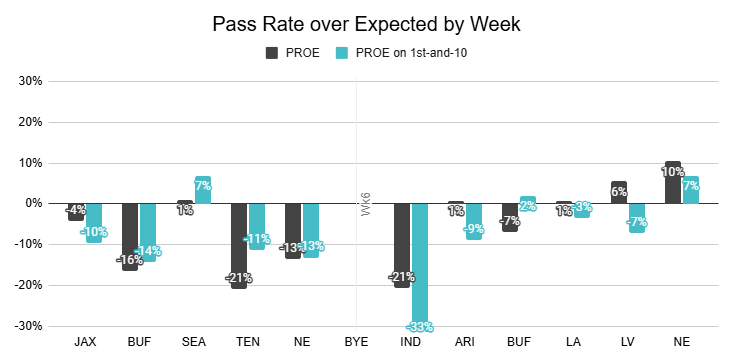
This led to a 67% pass rate, also the highest mark we’ve seen from a Tua-led offense this year.

But Tagovailoa now moves to a Packers defense that is going to work much harder to take his favorite throws away. They’re third-best at protecting the splash zone, and just generally much more effective against the pass than New England.

The Packers don’t have a great pass rush, which raises Tagovailoa’s floor. But I don’t expect McDaniel to test the pass rush a ton, with Miami’s potential for splash zone chunk plays being limited.
This week, we’re likely to see more of a conservative approach. That means less passing and less aggressive downfield throws.
The Dolphins have demonstrated that their baseline goal this season is to get the ball out very quickly and prevent Tagovailoa from seeing pressure. With a 2.41s TTT, Tua not only has the fastest TTT in the NFL, there’s a big gap down to Baker Mayfield (QB2), who sits at 2.55s. Tagovailoa also has the lowest pressure rate in the NFL by a significant margin.

This doesn’t mean Tagovailoa can’t be efficient here. He posted elite marks against the Bills and Raiders with aDOTs of 5.1 and 5.9 – on TTTs of 2.50s and 2.40s, respectively.
I should also note that last week, although Tagovailoa threw for 71 splash-zone yards on six attempts, the core of the Dolphins offense was still built around quick passing. Against New England, Tagovailoa had a lightning-fast 2.34s TTT and a 6.1 aDOT. Even if getting the ball out quickly and shallowly, he’s shown he can be efficient.

In fact, somewhat quietly, Tagovailoa has posted elite efficiency this year.

The quick-pass game has been very beneficial for De’Von Achane, who has seen 4+ targets in every game since Week 8. Over that span, he has 14 screen targets — Aaron Jones is second with a distant nine. Achane has also seen six targets on first reads, ranking RB7 over that span. Bottom line: McDaniel is calling plays to get him the ball.
Achane has not run efficiently this year. Which actually hasn’t changed in recent weeks. He’s averaging -8 RYOE over his last four games, with a negative mark in every single week. But he does get a mediocre Packers run defense, which should help. Still, it’s hard to count on him for strong rushing efficiency.

Instead, Achane’s high-end receiving role drives his value. Fortunately, that role looks like a safe bet here. He’s a high-end RB1.

Last week, Jaylen Waddle went off for 8/144/1 on nine targets, which was awesome to see after his slow start. With 101 of his yards coming on 10+ yard throws, he was a big beneficiary of last week’s soft matchup. That outing brings him up to a respectable 1.64 YPRR for the season… which is surprisingly close to Tyreek Hill.
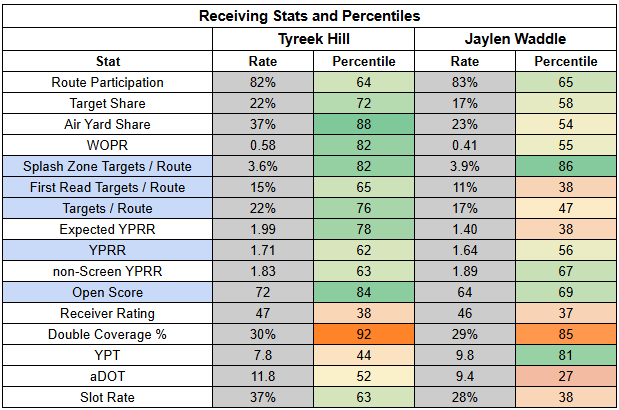
But Hill’s higher target rate and deeper aDOT point him as the clear upside option. It’s been a very disappointing season, but he’s a WR1. Waddle looks like a high-end WR3.
Both WRs are hurt by Jonnu Smith’s continued emergence. This used to be a highly concentrated offense. But Smith has worked into a seriously valuable role in the passing game. Over the last two weeks, he’s averaging nine targets for 7.5 receptions, 94 yards, and 1.5 TDs. It’s been fun to see.
Smith’s production will cool off, but the underlying role looks real. Since Week 7, we’ve seen a big shift in his route participation.

And Smith has been featured when on the field all season. He’s a TE1.

Packers Implied Team Total: 25.25
Jordan Love is coming off two strong outings, after a concerning stretch throughout the middle of the season.

Overall, he’s played well this year, profiling as a strong starter.

But Love’s play looks a bit matchup-dependent. He has been excellent when not facing the blitz, ranking QB1 in EPA per dropback (0.26). But against extra rushers, his play has fallen off a cliff to -0.43 EPA per dropback; only Deshaun Watson (-0.46) has been worse this year.
Love has been similarly inefficient under pressure, with -0.44 EPA per dropback (QB20) — and similarly efficient to when kept clean as when not blitzed, with 0.25 EPA per dropback (QB13).
Love has the potential to be a very productive QB, but we strongly prefer him against defenses that don’t pressure well and don't the blitz. To that point, Love’s recent solid performances were against a middling Bears pass rush that ranks 22nd in blitz rate and a below-average 49ers pass rush that ranks 30th in pressure rate, and was also missing Nick Bosa.
Things change this week. Love gets a Dolphins defense that ranks seventh in blitz rate. They also rank 12th in pressure rate and second in time-to-pressure. Their quick pressure has been boosted by the emergence of Chop Robinson, who had seven quick pressures last week and is averaging 4.5 per game over his last four, up from 1.5 per game in his first eight. Robinson is now up to fifth in pass rush win rate among EDGE players. He’s become a force to be reckoned with.

The Packers have a strong offensive line and should be able to hold up reasonably well here. But with the Dolphins’ willingness to blitz, we should also expect some inconsistency from Love.
And mediocre efficiency is a pretty big concern here since we can’t count on volume.
In positive game script and against a weak run defense, the Packers posted just a 39% pass rate last week… even lower than the ball control 42% pass rate they posted with Malik Willis under center in Week 3.
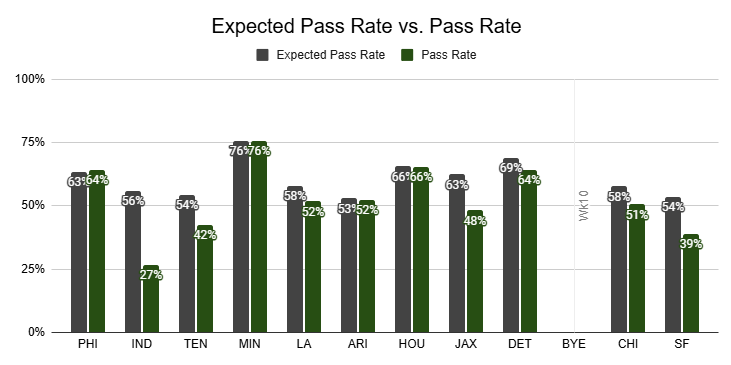
The Packers were extreme in their approach last wee, but not entirely out of character. They have been a conservative team all season.

But Miami is a difficult team to play overly conservatively against. They defend the run well.

In fact, with Tagovailoa playing well in recent weeks, opponents have largely been attacking Miami through the air.

This looks like a difficult matchup for the Packers. Love could be uncomfortable against Miami’s blitz packages, especially if the Packers' run game is putting him behind the sticks.
Josh Jacobs is in for a difficult test here, but is coming off a three-TD performance against the 49ers, and has run well all season.

His path to value is pretty narrow, meaning TD-dependent. He has just a 9% target share this year, and even last week, he saw only one target.
Still, while this matchup isn’t great, I'm more worried about offensive efficiency as a whole than about about Jacobs' workload. He should get a valuable rushing workload and is a high-end RB2.
In the receiving game, things remain as unpredictable as ever. Tucker Kraft posted 88% route participation last week… making him the only Packer at 70%+. Even with Romeo Doubs limited to just 54% route participation with a concussion, Christian Watson (69%) and Jayden Reed (65%) only played part-time roles. Dontayvion Wicks (42%) also helped pick up the slack. Granted, the Packers didn’t need to lean on their top weapons in a 38-10 win.
Assuming Doubs is out for this game, we should again see more Wicks. Although with Bo Melton (31% route participation) and Malik Heath (15%) also getting routes last week, it’s hard to trust Wicks to be in a full-time role.
This role uncertainty is frustrating since Doubs (21%) leads the Packers’ starting WRs in TPRR against the blitz, with Jayden Reed at 18% and Christian Watson at 17%. I’m assuming we’ll see a rotation with Doubs out, but it is possible that Wicks – who has a 29% TPRR against the blitz this year – is a bigger piece of the game plan this week.
Wicks has been heavily targeted when on the field. He just hasn’t done anything with those targets—probably why he’s stopped seeing the field so much. But with Christian Watson making an egregious drop on a wide open TD, perhaps the Packers give Wicks another shot.

Even after last week’s miscue, Watson has been pretty damn efficient this year, with a 2.08 YPRR. And his 18.7 aDOT provides upside, even if the offense struggles for consistency here.

Jayden Reed has been even more efficient this year, but his route participation and target share are both much lower than ideal. Still, he has the most to gain if the Packers are pushed into a competitive script where they have to lean on the pass more. He’s a high-end WR3.
Tucker Kraft’s target and yardage numbers remain unimpressive, but the dude sure likes scoring TDs. He has six on the season, which is tied with Mark Andrews for second, behind George Kittle (8). He’s a solid TE2.

Back to Quick Links




